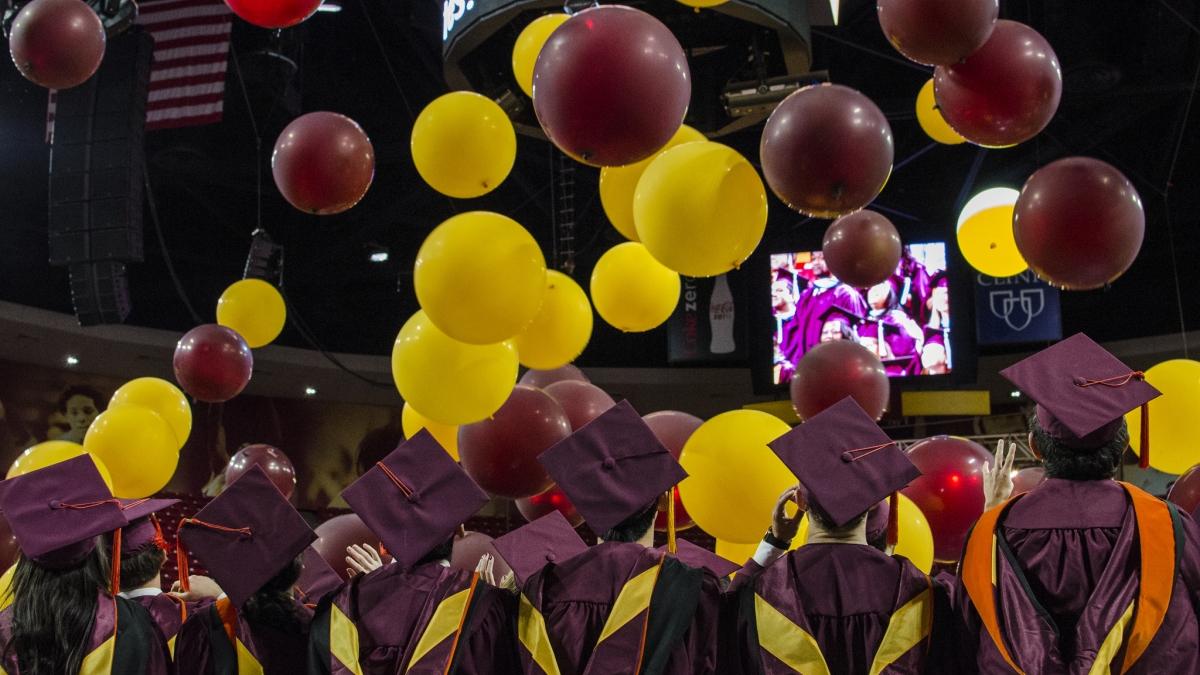Statistics for the Graduation Success Rate (GSR) released Wednesday by the NCAA indicated an 84 percent graduation success rate, an all-time high for Arizona State University.
ASU has either tied or surpassed its all-time best in each of the past nine years.
The GSR is based on student-athletes who entered college as freshmen in 2005-2008 and ultimately entered ASU on athletic aid as freshmen or transfers. The GSR allows for the removal of those individuals from the cohort who left ASU in good academic standing prior to completing their eligibility and is the NCAA’s primary tool for measuring academic success.
ASU’s stated goal when the GSR was introduced 10 years ago was 80 percent, which was reached in 2012. Ten years ago, ASU's GSR was at 69 percent, and it has seen a 15 percent increase since that point.
"We are proud of the continued and record-setting improvement in our graduation rate," said Ray Anderson, vice president of University Athletics. "Results measured by both graduation and competitive successes are keystones to defining the Sun Devil way. The student-athlete is the centerpiece of our department's efforts. Jean Boyd, his staff, and the coaches not only teach leadership, risk-taking, and teamwork, but also complement the invaluable academic growth gained from the classroom."
ASU’s women’s GSR is 90 percent, up one point from a year ago, while the men’s teams are over 70 percent (79 percent) for the third year in a row since the reporting began 11 years ago. The men’s GSR has improved from 56 percent in 2005. ASU shines in graduating African-American student-athletes, ranking second in the Pac-12 in both overall and in the African American male GSR.
ASU ranks fifth in the Pac-12 Conference (out of 12 institutions), just one percentage point behind Washington’s 85 percent, and two percentage points behind second place.
Four ASU teams lead the Pac-12 Conference, including men’s basketball (90 percent) and with three at 100 percent: women's golf, softball, and women's tennis.
Over the past seven years, the baseball program has elevated its GSR from 30 percent to 87 percent, while the men’s basketball GSR has improved from 31 percent to 90 percent over the last eight years.
“Sun Devil Athletics is dedicated to developing student-athletes who graduate and go on to live championship lives,” said Jean Boyd, senior associate athletic director of Student-Athlete Development. “Reaching an all-time high of 84 percent speaks to this commitment. We are especially proud of our work with our female and African American student-athletes. We also highlight the continued improvements made in men’s basketball and baseball. We will remain relentless in these efforts and look forward to reaching a short term goal of 85 percent and ultimately our targeted 90 percent.”
The GSR is the NCAA's more comprehensive calculation of student-athlete academic success. The NCAA rate is more accurate than the federally mandated methodology because it includes incoming transfers and students enrolling in the spring semester who receive athletic aid and graduate and deletes from the calculation student-athletes who leave an institution and were academically eligible to compete. The federal rate does neither.
Conversely, the APR, or Academic Progress Rate, is a year-by-year gauge of eligibility and retention for Division I scholarship student-athletes that was established in 2004. It is a composite team measurement based upon how individual team members do academically, and the NCAA APR threshold is 925, which is the equivalent of a 50-percent graduation rate.
This is the 25th release of institutional graduation rates since national "right-to-know" legislation was passed in 1990. In 2005, the NCAA Division I Committee on Academic Performance implemented the initial release of the team GSR data.
More University news

ASU Online ranked among best in the nation by US News & World Report
Arizona State University’s online programs continue to earn recognition among the nation’s best in the 2025 U.S. News & World…

ASU summer program honored with 2025 Award for Mathematics Programs that Make a Difference
The Joaquin Bustoz Math-Science Honors Program (JBMSHP) at Arizona State University has been honored with the 2025 Award for…

ASU student earns prestigious Schwarzman Scholarship to study in China
The day that Schwarzman Scholarship candidates began getting notified that they had been chosen for the prized scholarship,…


